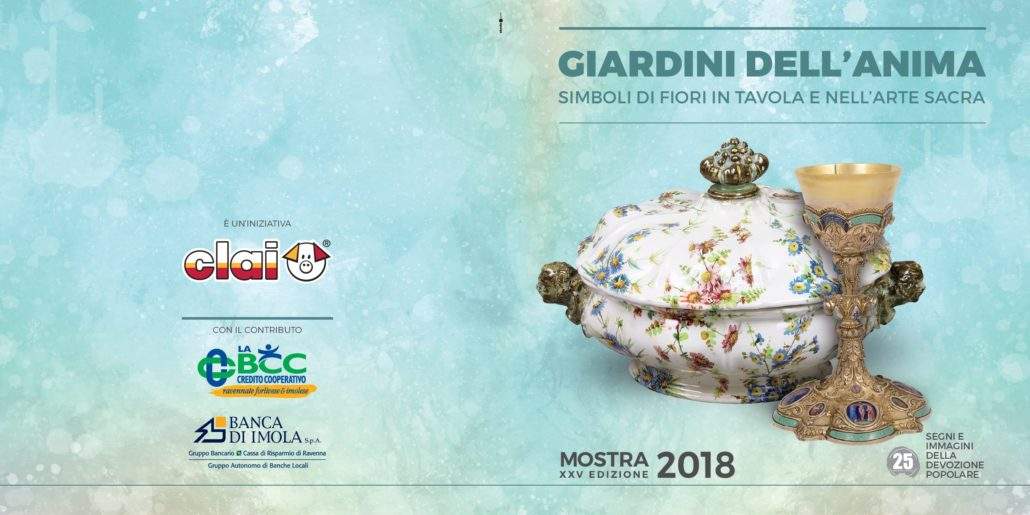On Saturday, Sept. 8 and Sunday, Sept. 9, an exhibition entitled "Gardens of the Soul. Symbols of flowers on the table and in sacred art, " organized by Clai on the occasion of the XXV edition of the artistic itinerary “Signs and Images of Popular Devotion,” which this year crosses the ambitious goal of a quarter century.
A fascinating journey linking culture, tradition and religiosity, this year, in a continuity solution with the past edition "Convivio, " further delves into the theme of the table by highlighting majolica wares and decorations datable between the first half of the 18th century and the eighth decade of the 19th century. Of different manufactures, eras and fashions, the ceramic materials on display find their lowest common denominator in floral decoration.
Marco Violi, curator of the exhibition, has divided the exhibition into fourteen sections, each dedicated to a flower: cornflower, buttercup, rose, white lily, tulip, carnation, anemone, columbine, daisy, peony, poppy, lotus flower, St. John’s wort, and oak. These are the fourteen plant essences featured in the exhibition and depicted on the majolica tiles on display-tureens, risers, trays, flat and dessert plates, cups and vases. Each flower finds its correspondent in religious symbolism. Each is then matched by a work of sacred art of which it is the symbol.
In fact, each section includes both ceramic materials and works of sacred art-paintings, goldsmithing and prints-including several previously unpublished ones.
The first section, for example, is dedicated to the cornflower, a symbol of Christ in Christian iconography that is often taken up in paintings of theAssumption of the Virgin, the Resurrection and theAscension. Here an elegant tureen made between 1883 and 1890 by the Cooperativa Ceramica d’Imola and decorated with bunches of cut flowers, among which numerous cornflowers stand out, is joined by a fine silver Venetian chalice, donated by Pope Pius VII to the Imola Cathedral Chapter, on the foot of which are four sculptures, one of which depicts the Assumption of the Virgin, since the cornflower is its symbol.
“The exhibition, ’Gardens of the Soul,’ undoubtedly offers the possibility of being able to admire all together, and for the first time, a conspicuous group of high quality artistic materials,” Marco Violi explains. "Contextually - and it seems to me this is an even more important element than the mere aesthetic fact - it allows us to reread spiritual history through legends that are lost in the mists of time among superstition, paganism and popular devotion. In the final analysis, therefore, to recover by means of natural signs and symbols, the spirit and strength of that millenary devotion, whose popular foundations have found a solid basis in the simplest knowledge of the time, a time in which nature, with the passing of the seasons, the scent and color of flowers, has played the role of a true global medium. Fourteen stories of flowers on which as many sacred stories are grafted: the former, because of their ephemeral beauty, remind us of the transience of earthly life; the latter, because they exemplify Christ, Our Lady and the lives of the saints, open wide a window to eternal life."
The exhibition, sponsored by the Diocese and the Municipal Administration of Imola, brings together more than fifty works, including several previously unpublished ones. The loaned materials come not only from churches in the Diocese (such as the Cathedral) and the local diocesan museum, but also from important public collections such as the MIC in Faenza and the Museum of Ceramics in Forlì, as well as from renowned antique galleries and private collectors.
Precious majolica from manufactures in Faenza(Ferniani and Vicchi), Bologna(Finck-Rolandi), Imola(Gaetano Lodi), Lombardy(Antonio Ferretti) and Florence(Ginori)-among which the selection of pieces, part of the monumental table service of the Kedivé of Egypt, dialogue with fine sacred goldsmithing (chalices, cope clasps, astylal crosses and episcopal rings from Venetian, Roman, Faentine and French workshops from the 16th to 20th centuries), paintings (including the large copper from the workshop of Carlo Dolci and the canvas by Giovanni Gasparro, as well as the rhini by Nicolá s Enríquez and Gregorio Vásquez de Arce y Ceballos), votive offerings and prints (including a rare sheet by Heinrich Aldregrever engraved in 1553).
"From the Madonnas of the Pillars started twenty-five years ago the exhibition path ’Signs and Images of Popular Devotion’ an initiative of CLAI to understand the value, historical and cultural heritage of the community to which we belong, of our territory," says Giovanni Bettini, CLAI President. "In recent years the exhibition has brought to the fore the centrality of CONVIVIO for the ’religious’ value of food, nourishment of body and soul. In this new edition of the Exhibition, the theme takes up these suggestions and presents us with an original path through the symbology of flowers: flowers in the decorations of plates, soup tureens, legume dishes and table apparatuses of great value, flowers in the iconographic representation of Saints and Madonnas, objects of worship and popular devotion. The theme GARDENS OF THE SOUL also leads us to a deep reflection on the beauty of diversity, diversity of forms, colors and scents. Diversity in seasons, growing times, blooms and fruits. By dwelling on the beauty of the works displayed in the Exhibition curated with great sensitivity by Marco Violi, we will draw from it a strong personal viaticum not to conform to the dominant thought."
Opening: Friday, Sept. 7 at 5:30 p.m.
Exhibition opening to the public: Saturday, September 8 and Sunday, September 9, 2018. Opening hours: 10 a.m. to 8 p.m.
 |
| Flowers in religious art: an exhibition in Imola where each section is dedicated to a flower |
Warning: the translation into English of the original Italian article was created using automatic tools. We undertake to review all articles, but we do not guarantee the total absence of inaccuracies in the translation due to the program. You can find the original by clicking on the ITA button. If you find any mistake,please contact us.